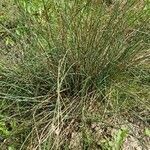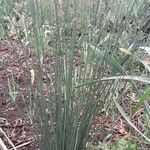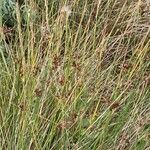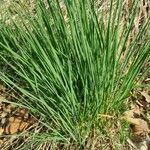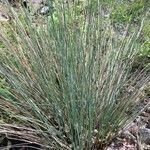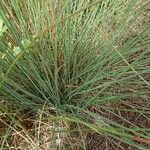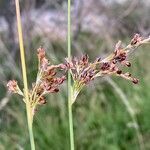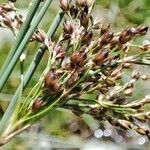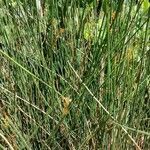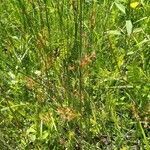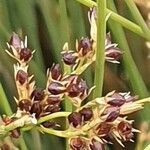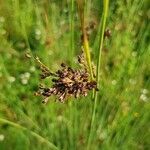Plants perennial, tufted. Stems terete, 40--80 cm × 1.2--4 mm; pith interrupted. Cataphylls closely embracing stem, reddish brown to brown, shiny or not, sheathlike, 1--13 cm. Inflorescences pseudolateral, many flowered in small, dense panicles; involucral bract erect, seemingly a continuation of stem, long. Bracteoles 2, broadly ovate to ovate-lanceolate. Perianth yellowish green at center; segments narrowly lanceolate, 2.5--3.5 × ca. 1 mm, subequal or outer ones larger than inner, margin thin, transparent, apex acute. Stamens 6, ca. 1/2 as long as perianth; filaments pale reddish brown; anthers ca. 0.7 mm. Ovary 3-loculed. Style shorter than ovary. Capsule yellowish green to chestnut brown, trigonous, ellipsoid, narrowly ovoid, or ovoid-oblong, 3--3.4 mm, subequaling or slightly longer than outer perianth segments, 3-septate, apex obtuse to acuminate, often mucronate. Seeds brown, obliquely ovoid to oblong, ca. 0.6 mm, reticulate. Fl. Jun--Jul, fr. Jul--Sep. 2 n = 38, 40, 42.
Perennial, tufted; rhizome matted, horizontal; roots thick. Stems up to 1 m tall, leafless, glaucous, wiry, sheathed basally with chestnut-brown, shiny cataphylls; pith interrupted. Inflorescence pseudolateral, subtending leaf forming apparent continuation of stem, about 1/4 of length of stem; anthelae compact, many-flowered, mostly on short to very short branchlets. Tepals linear, acute, outer somewhat longer, c. 4 mm long, firm, ribbed. Stamens 6, c. 2 mm long; filaments filiform, equalling anthers. Ovary cylindrical; style present with 3 long stigmas. Capsule ellipsoid, tricostate, 0.3 mm long, hard, dark brown, shiny, apiculate; seeds 0.4 mm long, ovoid, bulging unilaterally, reticulate, golden yellow, with a dark, obtuse apex and base, tips transparent.
Perennial, tufted herb, up to 1 m high. Leaves on linear, matted, horizontal rhizomes, cauliform, pungent, surrounded below by sheathing cataphylls. Scape leafless, glaucous, wiry, sheathed basally with brown cataphylls; pith interrupted. Inflorescence pseudolateral, with one subtending bract forming a continuation of scape, and two bracteoles; anthelae compact, many-flowered, mostly on short to very short branchlets. Perianth segments 4 mm long, linear, acute. Stamens 6, 2 mm long; filaments filiform, equaling anthers. Ovary cylindrical; style present with 3 long stigmatic arms. Capsule loculicidal, 3-valved, ellipsoid. Seeds 0.4 mm long, with dark, obtuse apex and base, apex transparent.
Herbs, perennial, cespitose, stooling, 4--10 (--12) dm. Rhizomes 3--5 mm diam. Culms terete, 1.5--3 mm diam. Cataphylls several. Leaves: blade absent. Inflorescences many flowered, open, 2--7 cm; primary bract terete, 10--25 cm. Flowers pedicellate; bracteoles ovate; tepals straw-colored to reddish brown, lanceolate, 2.7--3.5 mm, margins scarious; inner series loosely subtending capsule at maturity, shorter; stamens 6, filaments 0.8--1.5 mm, anthers 0.8--1 mm; style 0.3 mm. Capsules reddish brown to chestnut brown, 3-locular, 3-gonous-ovoid to widely ellipsoid, 3--4 mm, exceeding perianth. Seeds amber, obovoid, 0.3--0.5 mm, not tailed. 2n = 20, 38, 40.
Stems cespitose from a short rhizome, 3–8 dm, glaucous, finely striate, without foliage lvs; basal sheaths to 10 cm, purple-brown at base, bristle-tipped; invol lf 1–2 dm, a fourth to a third as long as the stem; infl appearing lateral, 3–6 cm, freely branched and many-fld; fls prophyllate; tep lance-acuminate, 2.6–4 mm, slightly shorter to slightly longer than the dark purple-brown, shining, trilocular, beaked fr; anthers 6, about as long as the filaments; 2n=40, 42. Native of Eurasia and n. Afr., intr. in wet meadows and along roads in our range, as in N.Y., Ont., and Mich.
Large dense tufts; rhizome short. Stems 25-60 cm × 1-1.5-(2) mm, stiffly erect, wiry, dull grey-green, prominently ridged, pith interrupted. Basal sheaths glossy dark purple-brown to black. Inflorescence 3-7 cm long, branches spreading or more densely packed. Flowers evenly spaced. Tepals 2.5-4 mm long, outer slightly > inner, all acuminate. Stamens 6. Capsule 2.5-3.5 mm long, ± = or slightly > tepals, ovoid, tapered to distinctly mucronate top, dark purple-brown.
Tufted, perennial herb, up to 0.9 m high. Leaves surrounded below by sheathing cataphylls, 70-170 mm long; blade cylindric, cauliform; pith in leaves and scapes interrupted, with lateral septas. Flowers: inflorescence placed ± one-fifth from top of straight scape; scape greyish green, with 12-16 prominent longitudinal ridges; each flower with a bract and 2 bracteoles; tepals 4 mm long, erect; stamens 6; perianth green; Nov.-Jan. Fruit acute, hard.
